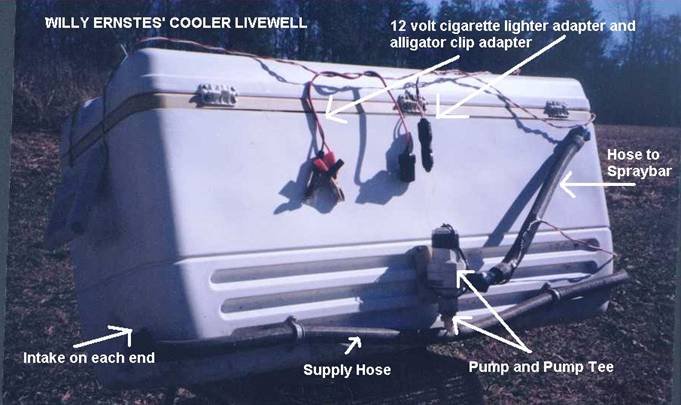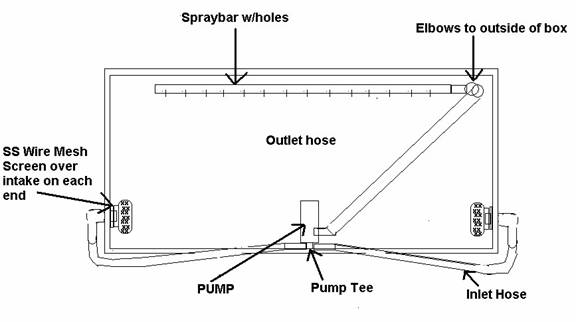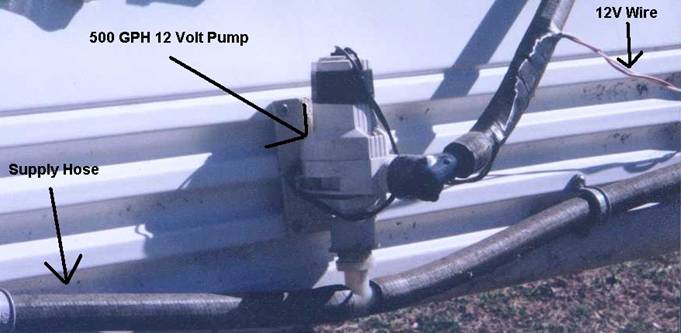How
to construct a Cooler Livewell for Large Catfish
By Willy Ernstes

This is an abbreviated version of an article I wrote that
was published by the National Catfish Association several years ago. The
fundamentals are still the same as they were then. If we want to continue to do
battle with monster catfish, we must do what we can to protect the fishery. The
most important and easiest thing that we as anglers can do is practice “Catch &
Release’. This is easily done on guided and recreational trips while on
vacation, but with the recent popularity of tournament fishing for catfish, it
is going to require more effort on the anglers to keep these magnificent fish
alive and healthy until weigh-in and subsequently the release after the
weigh-in.
Back when limits were five (5) fish and a five-fish
stringer would weigh 40 lbs, almost any boat’s livewell, or large bucket would
do the trick. Now, tournament stringers are down to 1 and 2 fish limits with
most winning fish weighing in the 40-50 lb. Range (or larger) so the small
“bass-type” livewells can no longer hold today’s catfish, much less, keep them
alive for 8-12 hours.
Some may offer that keeping monster catfish in a large
container and replenishing the water periodically will suffice. While this
method may keep the fish alive, fish will be severely stressed due to the lack
of oxygenated water and, in middle of summer, the excessively high temperature
of the water in the container.
Adding ice to such a container is also not encouraged as
the sudden drop in temperature stresses the fish, then upon release, the shock
of going back into very warm water further stresses the fish, sometimes
fatally.
One method I employ is a cooler box with a recirculating
pump and a spray bar to help cool the water. I’ve developed a very economical,
yet effective livewell for keeping large catfish during tournaments. It begins
with a 132-160 quart Igloo (or similar) cooler. I prefer the “marine” versions,
but there are some 150 quart Igloo coolers now available at area department
stores in the $60 range (much less than their “marine” cousins). The box size
depends on the size fish you will be (or hopefully will be) wanting to keep in
the livewell. Generally, a 32” – 40” fish will require a 132 qt. Cooler
minimum.
I plumb the cooler using a combination of readily
available household and marine plumbing hoses and fittings. The pump consists
of a 500 GPH thru-hull aerator pump that’s available from places like Bass-Pro
or Cabellas, and some sporting goods departments in area department stores or
marinas. Power to the pump is from a 12 foot wiring harness that is connected
directly to a battery with alligator clips or via a cigarette lighter adapter
plugged into your boat’s console. Wiring it with the cigarette lighter adapter
plus an adpater to convert the cigarette plug to alligator (battery) clips gives
the flexibility and portability of using the livewell on any boat with a 12 volt
power source. See Diagram 1 and 2 below:

<
The spray bar is fashioned out of a short mail order spray
bar that has been cut in half and made longer with a piece of PVC pipe. Be sure
not to add too many extra spray holes, as too many will not create the aerating
effect (pressure) required to oxygenate the water. That spraybar is
connected to the pump with an elbow on the inside of the livewell and one on
the outside, attached to a hose leading to the outlet on the pump.
Here is a close-up view of the pump
mounted on the back of the cooler livewell:

Tips on Construction
and Use:
·
Inlets to the pump (supply hose) come from both ends of the cooler
livewell. This promotes circulation of all the water in the livewell.
·
The Pump Tee (see diagram) must be mounted as low as possible
without going below the bottom of the livewell to promote self-priming. (You
may have to raise one end of the livewell to remove trapped air when first
filling it with water. Fill half-full and check)
·
Make fittings for intakes long enough to put a nut on the inside
to hold them in place. Also leave enough threads exposed on the inside of the
livewell to allow SS screens to be screwed onto the intake.
·
Drill hole for intakes high enough to allow screens to be
installed and removed for cleaning.
·
Mount Spray-Bar as high as possible inside the livewell.
·
The Long electrical wire allows you to move the livewell around in
the boat to determine best place for it to ride.
·
Cigarette adapter on wire with 12-Volt cigarette adapter to
Alligator Clips, allows you to use the livewell on any boat with 12 volts.
·
Replace water if its gets cloudy or contaminated with stomach
contents thrown up by your fish.
·
Always charge your batteries before going to a tournament.
Livewells need to run continuously.
·
Always leave the lid of the livewell cracked open to allow “spray”
to cool with the fresh air, otherwise, the water in the livewell could build up
heat.
| 